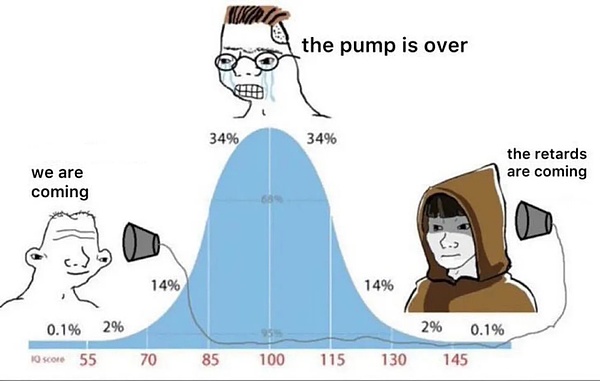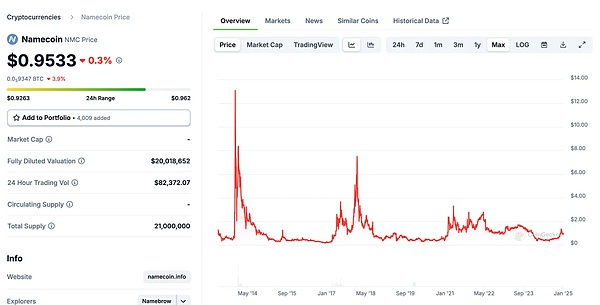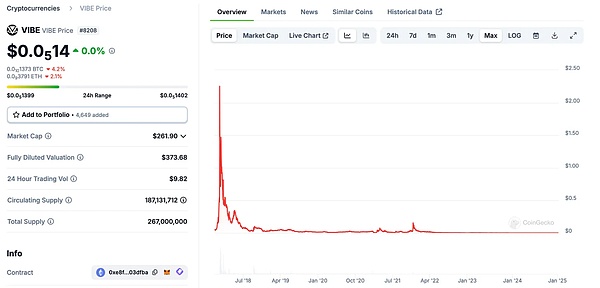Author: BowTied Bull; Translator: Vernacular Blockchain
With the arrival of 2025, we will summarize the past and look forward to the future as usual.
Looking back at the past of the crypto industry,we can find an interesting phenomenon, that is, there is a "altcoin season" every four years. During this period, you will find that everything in the industry is rising. It is very likely that you will hear that your alcoholic uncle also bought some animal emojis and made a fortune, even when he was drunk.
By 2025, the real altcoin season can be said to have not yet fully arrived. Although no one can predict how crazy this altcoin season will be, here I would like to remind everyone that the trend of Altcoins is generally out of control quickly and may end suddenly. Once a crash occurs, the decline may not only be -99.99%, but may even be a complete crash.
But before that, everyone is immersed in the atmosphere of prosperity and entertainment. So, let’s take a look back at past alt seasons to see how they fared and whether we can draw any valuable lessons from them.
012012-2013 alt season: Early enthusiasts, market cap up to $15 billion
We know that the current market’s blind followers are likely to reappear. This happened in 2013, and the trend became very interesting.

During the 2013 “alt season”, Bitcoin was still in its early stages of development, with a total market cap of only about $1 billion, and a whale transaction was only about $100,000. At the time, CEX Mt. Gox was still operating, and investors were mostly those who frequently appeared in the Magic: The Gathering trading card events (which was also the background of the Mt. Gox incident).
At that time, the idea of improving Bitcoin transaction speed was proposed, thinking that by reducing the block time, transactions could be accelerated, which was seen as a far-reaching innovation at the time.
Litecoin:Still exists today, and the whole idea (proposed by Charlie Lee) is to reduce the block time from Bitcoin's 10 minutes to 2.5 minutes.
The price of Litecoin rose from about 10 cents to $48, an increase of about 47,900%, and once again saw a sharp rise in 2017, and then Charlie Lee sold all his holdings at the top, claiming that "the Bitcoin network is fine without him" (everyone knows what it means when the founder sells 100% of his holdings).
Namecoin:This is a fork of Bitcoin that aims to create decentralized web domain names (similar to the concept of ENS through the ".eth" extension). Its price once soared to about $13, but soon fell to the bottom. From the lowest point to the highest point, its price increased by about 30 times. In fact, it still exists today, currently trading at nearly $1.
 Peercoin (PPC): This was one of the earliest Proof-of-Stake tokens (the same mechanism used to secure ETH today), and experienced two major surges. The first was in 2013, and the other was in 2017 when the ETH 1CO craze broke out. Its price once soared to about $7, a 60-70x increase. Naturally, it did not gain mainstream adoption and eventually fell to $0.42. (But the next conclusion is that except for pure Ponzi schemes like Bitconnect or LUNA, nothing else on the market will really go to zero at present.)
Peercoin (PPC): This was one of the earliest Proof-of-Stake tokens (the same mechanism used to secure ETH today), and experienced two major surges. The first was in 2013, and the other was in 2017 when the ETH 1CO craze broke out. Its price once soared to about $7, a 60-70x increase. Naturally, it did not gain mainstream adoption and eventually fell to $0.42. (But the next conclusion is that except for pure Ponzi schemes like Bitconnect or LUNA, nothing else on the market will really go to zero at present.)
The Craze: Bitcoin eventually reached $1,200, and these cryptocurrencies rose due to the increase in people's interest in crypto. Any project that posts on BitcoinTalk can quickly rise based on speculation alone. The closest thing to this today is probably a Memecoin promoted by a celebrity or named after a celebrity.
Mt. Gox Collapse:The party was over when Mt. Gox collapsed. The crash was caused by a major hack and caused a massive drop in the price of Bitcoin, probably 85-90% (depending on how you look at the bottom), while Altcoins dropped more than 99%.
02 2017 Altcoin Season: ICO Mania and the Rise of Ethereum, Market Cap Peaks at $800 Billion
A lot of interesting things happened during the subsequent bear market. Ethereum was born as a smart contract platform with the goal of creating programmable money. This was a real innovation because it completely changed the game by allowing people to not only transfer tokens, but also create smart contracts.
Like many things in the cryptocurrency space, Ethereum comes with some of the usual risks. Ethereum’s DAO (decentralized autonomous organization) was hacked, losing over $100 million, which ultimately led to the blockchain forking into two chains, ETH and ETC. To this day, some still believe that the decision to fork was a mistake, but we’re not going to discuss that today, just a brief review of history.
Around 2016, people realized that new tokens could be issued on the Ethereum blockchain, which led to the initial coin offerings (ICOs). In ICOs, the project sold tokens directly to investors. In 2017, the ICO craze officially broke out, and many scams you can think of emerged at this time.
Ethereum (ETH): Since ETH was required to issue these tokens, it drove the price of ETH up rapidly, soaring from about $8 to $1,400 in January 2018, an almost unimaginable return at the time. Currently, ETH is trading at around $3,650.
Ripple (XRP):Ripple is still seen as a “bank coin” and the theory is that it will replace SWIFT (the international money clearing system) overnight as the de facto financial standard. Despite being centralized (but most people don’t mind), it has attracted millions. The price of XRP has soared from about 1 cent to $3.80 and is currently trading at $2.41.
Oddly, the investor base for XRP is still mainly retail investors. You can see a similar phenomenon in the recent rally - XRP dominated TikTok and attracted a lot of discussion, even asking “what if it gets the same market cap as Bitcoin?” This “four trillion dollar market cap” discussion is a bit unbelievable.
Litecoin:As mentioned before, Litecoin has risen again, with the price soaring to $360. Although Charlie Lee sold all his Litecoin, it still hit $384 again in 2021!
EOS:EOS raised $4 billion through ICO and called itself the "Ethereum Killer". Its price once soared to $22, but it has not been able to reach a new high since then.
NEO:Another project that claims to be an "Ethereum Killer", it was called the "Ethereum of China". At that time, the price of NEO rose from $0.20 to $200, achieving a 1,000-fold return.
Bitcoin Cash:Roger Ver was once a well-known figure in the Bitcoin circle. He participated in the debate over large blocks and supported Bitcoin Cash. At block 478,559 in August 2017, users who held 1 Bitcoin would receive 1 Bitcoin Cash. Due to Roger Ver's support, the price of Bitcoin Cash once soared to about $3,800, but then gradually faded out of people's sight.
Other Ethereum Killers:During this period, some other tokens were also promoted as "Ethereum Killers" (such as ADA, Tron, etc.). If a token had a “white paper”, it seemed to drive its price 10x, 100x. Other tokens, like Filecoin and Tezos, also launched during this period.
Yield Scams:If you think BlockFi, LUNA, Celsius, and Voyager were the first yield scams, you’d be wrong! In fact, the first large-scale yield Ponzi scheme was Bitconnect, and many people lost millions of dollars.

Regulators Step In:Just like the 2021 cycle, regulators stepped in and Ponzi schemes broke out, destroying the industry again. The SEC began going after projects like EOS, and the market experienced a solid 85% correction, with Bitcoin prices falling to around $3,500 by March 2020.
During that period, most tokens were just scams, so the Altcoin market experienced a plunge of almost -99.999999%. At that time, if your token appeared in a Super Bowl ad, its price could rise fivefold in an instant. For example, VIBE is a typical example.
VIBE's price once soared from $0.04 to more than $2, but in the end its total market value fell to only $262.

03 2021 Altcoin Season: DeFi, NFT and Memecoin Market value up to $3 trillion
In 2021, for well-known reasons, everyone worked from home, staring at computers and mobile phones and doing nothing. The US government printed $10 trillion in currency, and this is just the US government's spending.
DeFi projects boosted liquidity mining, NFTs made JPEG images mainstream (selling for millions of dollars), and Memecoin valuations reached ridiculous levels.Bitcoin broke $69,000, ETH reached $4,800, and the total cryptocurrency market cap exceeded $3 trillion in November 2021.
Dogecoin: Started as a joke, but with Elon Musk's interest in the coin, its price began to rise parabolically, becoming a hot topic on the forum platform Reddit. Today, it is almost Elon's meme coin, representing the government efficiency department. The price soared from about 0.5 cents to 74 cents, an increase of about 15,000%.
Solana: Promoted as the next "Ethereum killer", it attracted a lot of attention with its fast transaction speeds and low fees. This was mainly promoted by SBF (now in prison). The price soared from $1 to about $260, an increase of 26,000%.
Shiba Inu:The meme coin that mimics Dogecoin has created a large number of millionaires. If you look at the market value from almost zero, it has increased by 500,000%.
DeFi Token:DeFi Tokens such as AAVE, UNI, SUSHI, and YFI have increased by 10x to 50x, and the decentralized finance (DeFi) locked funds (TVL) have exceeded hundreds of billions of dollars. Today, the TVL of many DeFi projects is even higher than it was then!
NFTs:
CryptoPunks:Sold for millions of dollars, with the cheapest CryptoPunk costing more than 100 ETH.
Bored Ape Yacht Club (BAYC):It has become a cultural phenomenon, and the lowest price has also reached an incredible level.
Airdrop Madness:For old users of some projects, just owning a .eth domain worth $100 can get a $40,000 Airdrop. You can even get 2% in a day or week by crossing a bridge (completing certain operations). NFT projects like BAYC have also Airdropped a large number of other highly valued NFTs, and the total Airdrop amount is as high as billions of dollars.
What's even crazier is...almost all tokens are rising.Tokens like SAFEMOON are being promoted by people like Dave Portnoy. Celebrities like Snoop Dogg and Paris Hilton are also endorsing various projects. Tom Brady and Stephen Curry are promoting cryptocurrency exchanges. Even the now-defunct FTX once paid for the naming rights of the Miami Heat. FTX (now defunct) even bought the naming rights of the NBA Miami Heat.
Ponzi Schemes:A large number of Ponzi schemes have emerged. While some have accused us of being involved in these scams, we were not. Fortunately, many people have managed to avoid large losses. It is never a wise move to invest in these products and entrust your assets to others.

Death Spiral: As liquidity began to dry up (the financial assistance previously provided to these projects no longer appeared), we saw the collapse of the aforementioned Ponzi schemes. In addition, FTX collapsed due to stealing user funds, and then the US Securities and Exchange Commission (SEC) stepped in again to regulate. Various large-scale scams and leeks-cutting incidents eventually led to a period of strict regulation of the entry and exit channels of the crypto industry.
04 Key Lessons
1) Take Profits in Time: The market moves quickly and you are likely to feel greedy. If you find yourself saying “I wish I had bought 2x more of XYZ”, then you should probably sell half of your position and take the gains. It doesn’t matter if you sell Bitcoin, Ethereum, or stablecoins, the point is not to be greedy. 2) Hype cycles are repetitive: Every alt season has a narrative theme: Bitcoin forks, ICOs, DeFi, NFTs, or Memecoins. If you find a theme, it’s best to stick with it because the knowledge you’ve accumulated in that area tends to disappear quickly at the end of the cycle. Instead of jumping around, focus on one area and pick the ultimate winner. 3) Risk management is critical: The gains are very impressive, but everyone’s situation is different. You are different from me, and I am different from my neighbor. Make a plan that works for you and stick to it, don’t keep adjusting your goals because some guy with $100,000 said “$10 million is not enough for retirement.”
4) Survivors will thrive:Altcoins come and go, but Bitcoin and Ethereum dominate every cycle. If a project has been around for that long, the risk of it going to zero is relatively low. Solana may also be close to this level if it can find practical applications that surpass Pump.fun in 2025.
Have we learned anything from Ponzi schemes? Actually, no. From what we have seen, people still don’t understand the concept of “Not Your Keys, Not Your Coins”.You can buy crypto stocks or other leveraged crypto assets at a brokerage firm, but understand that if you hold these stocks or crypto ETFs, you don’t actually own any cryptocurrency. You can never know what these companies or projects will do with the assets you put in.
In the bull market, we are often criticized for not participating in the hype of the latest Memecoin. Although these speculative behaviors seem to be very hot at the moment, if you observe carefully, you will find that those who stick to their strategies and keep calm have gradually accumulated.
In contrast, those speculators who only want to get rich quickly through "10 times the return" may attract market attention in the short term, but their funds and strategies are far from comparable to those anonymous big players who continue to invest steadily and accumulate wealth every month. These big players usually have a more solid financial foundation and clearer long-term plans. In the end, the performance and data of the market will prove what kind of strategy is the key to success.
Finally, I wish you all good luck in 2025.
 Alex
Alex
 Alex
Alex Miyuki
Miyuki Weiliang
Weiliang Brian
Brian Alex
Alex Alex
Alex Catherine
Catherine Kikyo
Kikyo Catherine
Catherine Kikyo
Kikyo